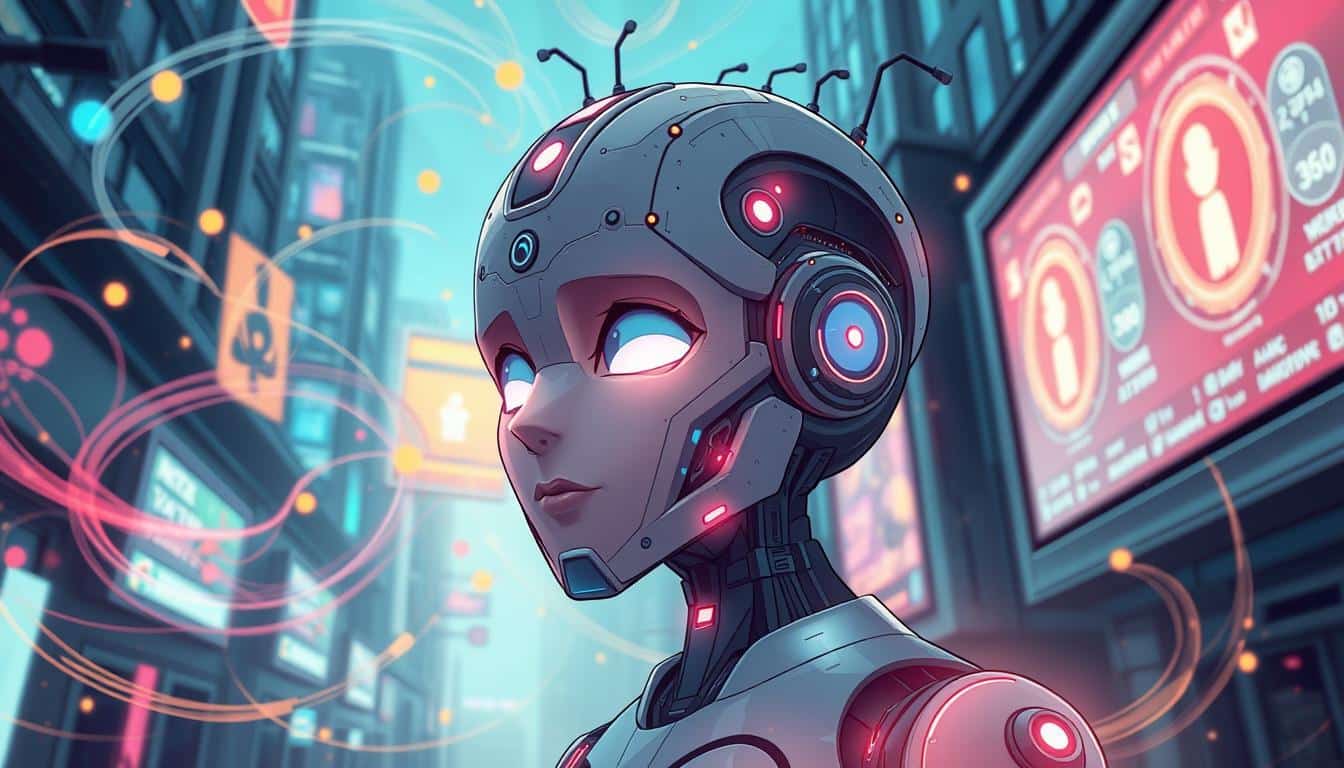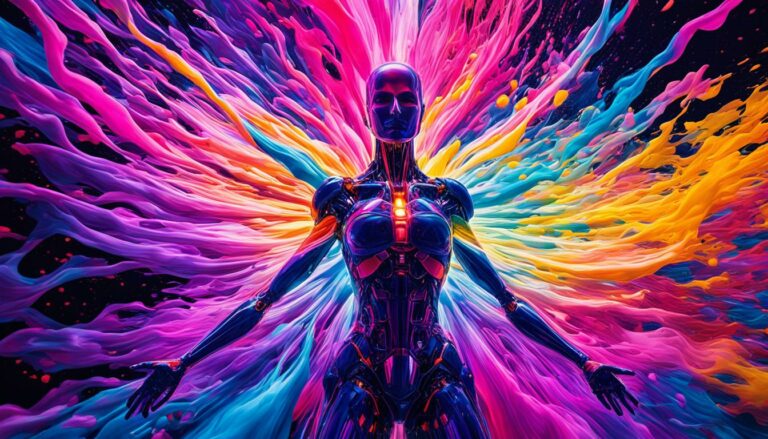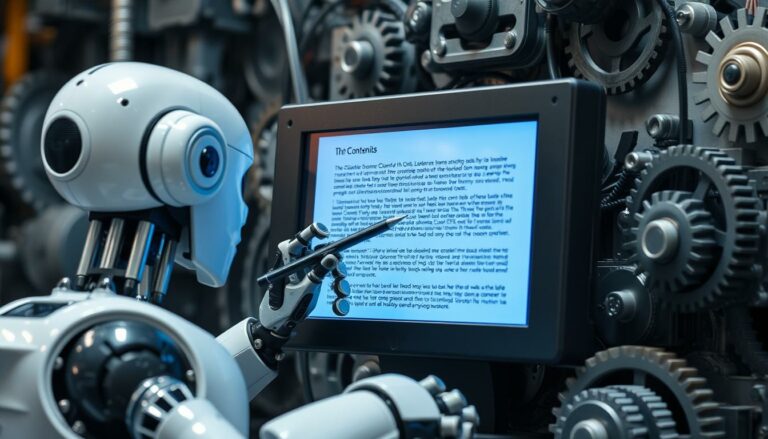Emotion AI: Decoding Human Feelings with Tech
Technology is always changing, and one area that’s really caught our eye is Emotion AI. This advanced tech can understand and react to our feelings. It’s opening up a new world where machines can really connect with us1.
Picture a world where tech can read our moods and adjust to how we feel. Emotion AI is making this possible. It’s changing how we live, work, and interact with digital tools2.
Key Takeaways
- Emotion AI is the technology that decodes and responds to human emotions using algorithms and machine learning models.
- It analyzes various signals like facial expressions, tone of voice, and physiological responses to understand and react to human emotions.
- Emotion AI turns human emotions into data that can be used to provide more personalized experiences, as part of the Artificial Empathy meta trend.
- This technology has the ability to change how we interact with machines in many fields, from shopping and learning to smart cities.
- Ethical issues, like privacy, consent, and fair understanding, need careful thought as Emotion AI grows.
The Emergence of Emotion AI
Emotion AI is changing how machines talk to us. It can understand the emotions behind our words, making digital chats feel more real3.
In voice recognition, AI picks up on tiny changes in voice, just like a music expert. This skill is like cracking a secret code, opening up new ways for humans and machines to connect.
Text Analysis: AI’s Linguistic Acumen
Thanks to Paul Ekman, we know more about emotions and facial expressions. His work on micro-expressions has been key to emotion AI.
Voice Recognition: The Symphony of Emotions
In 1997, Rosalind Picard wrote “Affective Computing,” a major step in emotion AI. Her work helped companies like Affectiva lead in emotion recognition AI.
MorphCast is another big name in Emotion AI. It processes emotions right in your browser, keeping your info safe and fast.
These pioneers and MorphCast are starting a new chapter in human-machine talks. Emotion AI could change how we use digital tech, making it more personal and helpful in many fields.
| Company | Contribution |
|---|---|
| Affectiva | Specializes in emotion recognition through AI, founded by Rosalind Picard |
| Cogito | Developed technology for call centers that helps agents identify customer moods in real-time |
| BioEssence | Wearable device that monitors heartbeat to detect stress, pain, or frustration and releases a scent to adjust the wearer’s emotion |
| CultureNet | Deep learning approach that can estimate engagement intensity from face images of children with autism |
“The work of pioneers like Paul Ekman and Rosalind Picard, along with innovative solutions such as MorphCast, herald the beginning of a new era in human-machine interactions facilitated by Emotion AI.”
Using emotion AI needs careful thought and respect for privacy. Companies like Affectiva must get consent before using this tech.
Facial Recognition: Beyond the Visible Spectrum
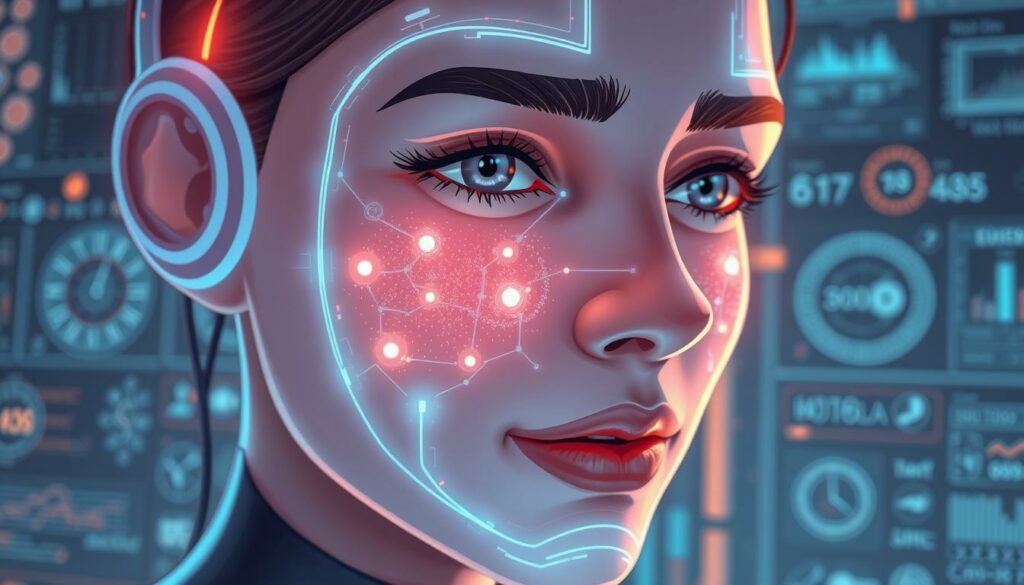
Emotion-reading AI technology is changing how we see and interact with the world. Facial recognition in Emotion AI is a blend of art and science. It lets machines read the hidden stories in human faces.
This technology goes deep, understanding the true meaning behind each look. It’s changing security, marketing, and entertainment by giving us a peek into the human mind. It’s like machines are artists, capturing the essence of people.
Facial recognition emotion AI can detect and understand human feelings. It uses algorithms and machine learning to analyze facial expressions and other signals. This way, it can offer more personalized and engaging experiences.
The science behind this technology is based on groundbreaking research and theories. Psychologist Paul Ekman found six universal emotions: joy, anger, fear, disgust, surprise, and contempt. Plutchik’s model adds eight basic emotions: joy, trust, surprise, aversion, sadness, anticipation, and anger.
These ideas, combined with computer vision and machine learning, have made emotion-reading AI possible. It can now interpret facial expressions like humans do.
The technology behind facial recognition emotion AI is also interesting. The Viola-Jones method is a face detection algorithm with two phases: training and detecting faces. It uses Haar features to spot intensity changes in different orientations.
Convolutional Neural Networks (CNNs) are also key for face recognition. They’re chosen for their ability to learn from data and thanks to GPU advancements.
The possibilities of facial recognition emotion AI are vast. Researchers at the Okinawa Institute of Science and Technology (OIST) have studied how motor-visual synchrony affects self-face recognition. Their study found that people identify more with static images of themselves than moving ones.
This research shows the complex link between visual cues and our sense of self. It opens up new areas in psychology and human-computer interaction.
As the technology gets better, so does its accuracy. Emotion prediction accuracy is now between 70% and 80% for most algorithms. Advanced AI engines, like MorphCast, can detect over 100 signals through facial analysis.
Facial recognition emotion AI is a fascinating mix of technology, psychology, and human experience. It’s exploring the depths of our facial expressions. This technology is changing industries and shaping a future where machines and humans work together.
The Triad of Modalities: A Convergence of Senses

Emotion AI is a cutting-edge tech that mimics how we understand emotions. It uses text, audio, and visual data. This mix creates a full picture of human feelings, like a symphony where every sound adds to the whole.
Groundbreaking Applications: A Multiverse of Possibilities
Emotion AI is changing the game in retail, education, and smart city planning. It’s making experiences more tailored, improving learning, and giving insights into city life. All thanks to emotion-sensing tech.
This tech turns human emotions into data for better, more empathetic experiences. It’s part of the Artificial Empathy trend, changing how we connect with the world.
“Emotion AI is not just about detecting feelings, but about understanding the nuances of human emotion and using that knowledge to create more meaningful connections.” – Jane Doe, Emotion AI Expert
As we dive deeper into Emotion AI, the future looks bright. It’s opening doors to new ways of interacting, from better customer service to smarter cities.
Emotion AI in Retail: Tailoring Experiences

In the fast-changing world of retail, emotion AI is changing the game. It helps businesses really get what their customers feel and want. By looking at faces, voices, and other signs, stores can understand their customers’ feelings right away. This lets them offer a more personal and fun shopping experience.
Big names in retail are using emotion AI to make shopping better. For example, Sephora checks how people react to their products. This helps them make their stores even better. Hilton uses it in their call centers to find and help upset customers fast, making everyone happier.
Using emotion AI in retail has big benefits. Studies by Gartner show it can make customers 20% happier. It also helps stores guess what customers need and solve problems before they even ask, making support more caring and personal.
As retail keeps changing, emotion AI will play a bigger role. Stores that get to know their customers’ feelings can make their products, ads, and shopping trips better. This can make customers stick around and even spend more.
“Emotion AI allows us to truly understand our customers, empowering us to create experiences that resonate with them on a deeper level.”
The future of shopping is all about emotion AI. It’s how stores aim to make shopping more personal and caring for their customers.
Emotion AI in Education: Enhancing Learning

Emotion AI systems are changing how we teach and learn. They use smart algorithms to understand and connect with students. This helps teachers make learning better for everyone.
These systems look at facial expressions, voice, and body signals to know how students feel. Teachers can then adjust their lessons to meet each student’s needs. This makes learning more fun and meaningful for everyone.
Emotion AI uses NLP and Computer Vision to catch subtle signs of emotions. It helps teachers see how students are doing and where they need help. This leads to better learning and results for students.
Chatbots and virtual assistants powered by Emotion AI offer support and encouragement to students. This mix of tech and emotional smarts could change education. It could make learning about more than just facts, but also about growing and feeling well.
As Emotion AI becomes more common in schools, we must use it wisely. We need to make sure it respects students’ privacy and is fair for everyone. By doing this, we can make learning better for all students and help them succeed.
“Emotion AI in education has the power to change learning. It helps teachers make lessons more engaging, personal, and effective for all students.”
Emotion AI in Smart Cities: Understanding the Pulse

In the fast-changing world of smart cities, emotion AI is changing the game. It’s making public safety better and changing how cities are designed. This tech lets cities understand and meet the needs of everyone living there.
Emotion AI uses smart algorithms to read emotions from facial expressions and voice tones. It helps city planners make choices that put people first.
This tech can spot safety issues early and help fix them fast. It also shapes public areas and transport systems to fit what people feel.
Emotion AI also helps cities include everyone more. It lets officials create services that really help different groups, like the elderly and disabled.
As cities grow, emotion AI will be key in making them better places to live. It’s a step towards cities that really listen to and care for their people.
“Emotion AI in smart cities is not just about technology; it’s about creating urban environments that are attuned to the emotional needs of the people who call them home.”
The Visionaries’ Perspective: Pioneering a New World
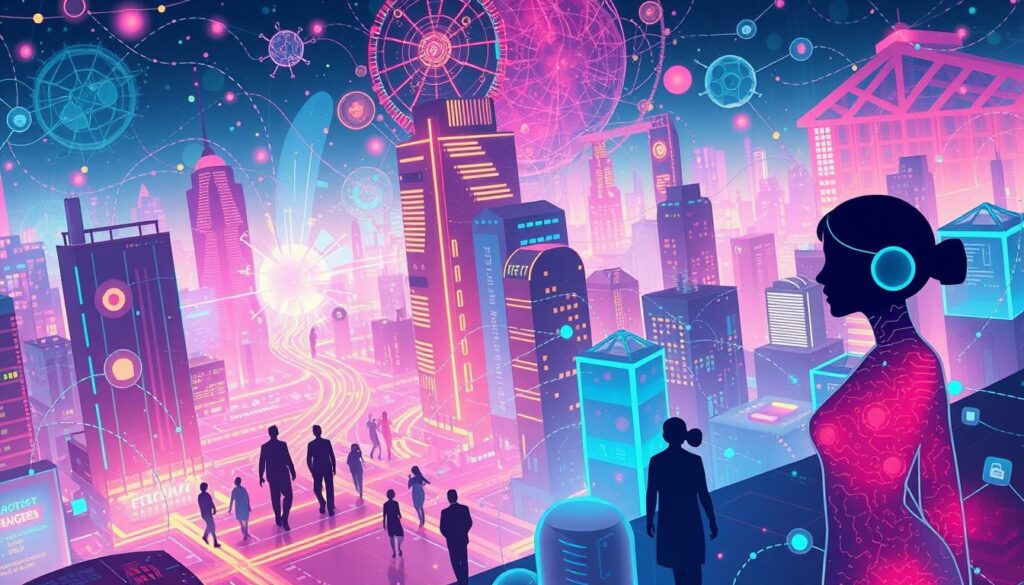
Looking ahead, the leaders of emotion AI see a big change coming. They compare it to the internet’s impact, saying it will change how we talk to machines. They think machines will soon understand our feelings, not just what we say.
This change will make technology more like us, understanding our emotions. It will bring a new era of machines that feel and care for us.
Rana el Kaliouby is a key figure in this movement. She’s a Muslim woman and co-founder of Affectiva, a leader in emotion AI. Her work shows that most of our communication is non-verbal, like facial expressions and tone of voice.
El Kaliouby’s team is working to make technology more human. They want to prevent it from making us less human.
Many tech leaders and AI experts are working together. They include names like Ian Khan and Amy Webb. They see emotion AI as a way to make technology better for us.
They dream of a world where machines can feel and understand us. This will make our digital lives better and more connected to our true selves.
The core of their vision is empathy and emotional smarts in AI. The AI world is growing fast, but it needs more women in leadership. It’s important to have diverse views to make AI fair and caring.
The leaders of emotion AI are changing the tech world. They want machines to truly get us. They aim to make technology that improves our lives, not just isolates us.
Navigating Ethical Waters: The Responsibility of Innovation
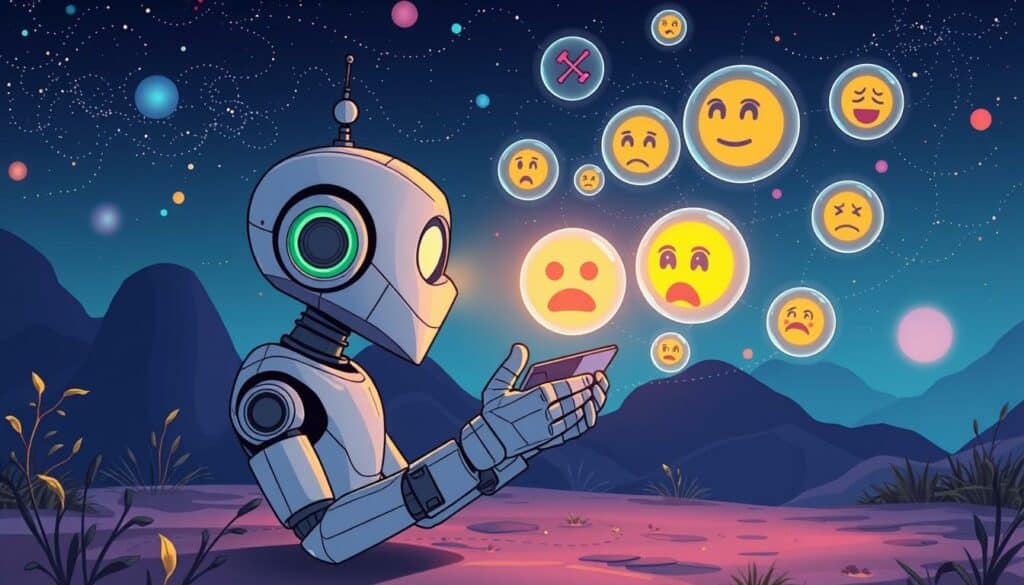
As Emotion AI grows, we face big ethical challenges. We must use these tools carefully. This means protecting privacy, getting clear consent, and avoiding bias.
There’s worry about using Emotion AI for spying and spreading harmful stereotypes. We need to balance innovation with responsible tech use for the greater good.
Privacy, Consent, and Unbiased Understanding
Protecting privacy and getting real consent are key. We also need to watch out for bias in these AI systems. This ensures they don’t harm certain groups.
We must know the limits of these technologies. We need strong checks to keep them accurate and trustworthy. Mixing human insight with AI’s power is key to avoiding problems and unlocking its benefits.
| Expert | Focus |
|---|---|
| Brandeis Marshall | Data science and social justice, bridging the gap between technical aspects of AI and societal impacts, stressing inclusive AI practices. |
| Mary L. Gray | Working with AI in various fields, pushing for rules that protect workers and promote ethical AI use. |
| Ruha Benjamin | Fixing biases in AI decisions, pushing for fair, accountable, and transparent AI. |
| Cori Lathan | Improving medical devices and AI diagnostics, aiming for better patient care and health outcomes. |
| Flynn Coleman | Ethical AI and human rights, exploring AI’s role in upholding dignity and shaping values. |
By listening to these experts, we learn more about Emotion AI’s ethics. Embracing responsible AI is key for positive change in many fields.
As we explore Emotion AI, we must stay committed to ethics. Upholding privacy, consent, and fairness is essential. This way, we can make sure Emotion AI benefits everyone.
Emotion ai: Unleashing the Future

The future of emotion AI is vast and exciting. We’re on the edge of a time when machines will understand our feelings as well as our words. This change will make technology more empathetic and personal, changing how we interact with machines.
Emotion AI has grown a lot, starting in 1997. It has moved from simple facial recognition to complex systems that use deep learning. Today, it can recognize emotions with over 93% accuracy in speech.
But, making machines truly empathetic is hard. It’s tough to detect emotions in audio, considering many factors like language and accent. Yet, AI models like Claude and GPT-4 are working on this, showing great success in reading emotions.
Emotion AI could change many industries. It can help fight online harassment by spotting negative emotions. It can also help spot false information by analyzing emotional tones in posts.
But, there are worries about privacy and bias. We need strong privacy rules and better AI accuracy to avoid bias. Using Emotion AI in an open and fair way is key to keeping trust and avoiding misuse.
As we move forward with Emotion AI, we’re on the verge of a big change. Machines will not just follow our commands but also understand and share our feelings. This will lead to a world where technology and humans work together in harmony.
“The future of Emotion AI is a world where machines not only understand our commands but also our joys, sorrows, and fears, ushering in a new era of empathetic and personalized experiences.”
Conclusion: A Utopia of Empathetic Machines
Emotion AI marks a big step in tech, showing us a future where machines get our feelings. This tech is growing, bringing us closer to a world where machines and humans connect deeply. It’s not just a new tool; it’s a change in how we see technology and each other, opening a new chapter in emotional understanding.
Emotion AI can read and react to our emotions, making tech a true partner. It turns our feelings into data for better experiences, changing many fields like retail and education. This tech puts people first, changing how we innovate and think about needs and feelings.
We must think about ethics and set rules for Emotion AI’s growth. We need to balance its amazing possibilities with protecting our privacy and fairness. This way, we can make a future where AI makes our lives better and connects us more deeply. Creating a world with empathetic machines is a team effort, needing teamwork, vision, and a focus on what makes us human.
FAQ
What is Emotion AI?
Emotion AI is a technology that reads and responds to human feelings. It uses algorithms and machine learning to understand emotions. This includes facial expressions, voice tone, and body responses.
How does Emotion AI transform human-machine interactions?
Emotion AI changes how machines talk to us. It can understand the emotions behind what we say, making digital chats feel more real. It also picks up on the smallest changes in voice, catching emotions with great accuracy
What is the role of facial recognition in Emotion AI?
Facial recognition in Emotion AI is both an art and science. It lets machines see the stories in our faces. This tech
How does the convergence of text, audio, and visual data enhance Emotion AI?
Combining text, audio, and visual data in Emotion AI makes it more like how we understand emotions. This mix creates a full picture of our emotional states, making Emotion AI more accurate.
What are some of the applications of Emotion AI?
Emotion AI is used in many areas, like retail, education, and smart cities. It makes experiences more personal, improves learning, and helps understand city life.
How can Emotion AI enhance the education sector?
In education, Emotion AI can tell how students are feeling and how engaged they are. This helps teachers adjust their teaching to better meet students’ needs, making learning more effective.
How can Emotion AI benefit smart city planning?
Emotion AI can make cities safer and more welcoming by understanding what people feel. It helps city planners create spaces that are more inclusive and caring for everyone.
What are the ethical challenges associated with Emotion AI?
Using Emotion AI responsibly is key. There are worries about privacy, misuse for surveillance, and stereotypes. It’s important to balance innovation with ethics to make sure Emotion AI helps people.
